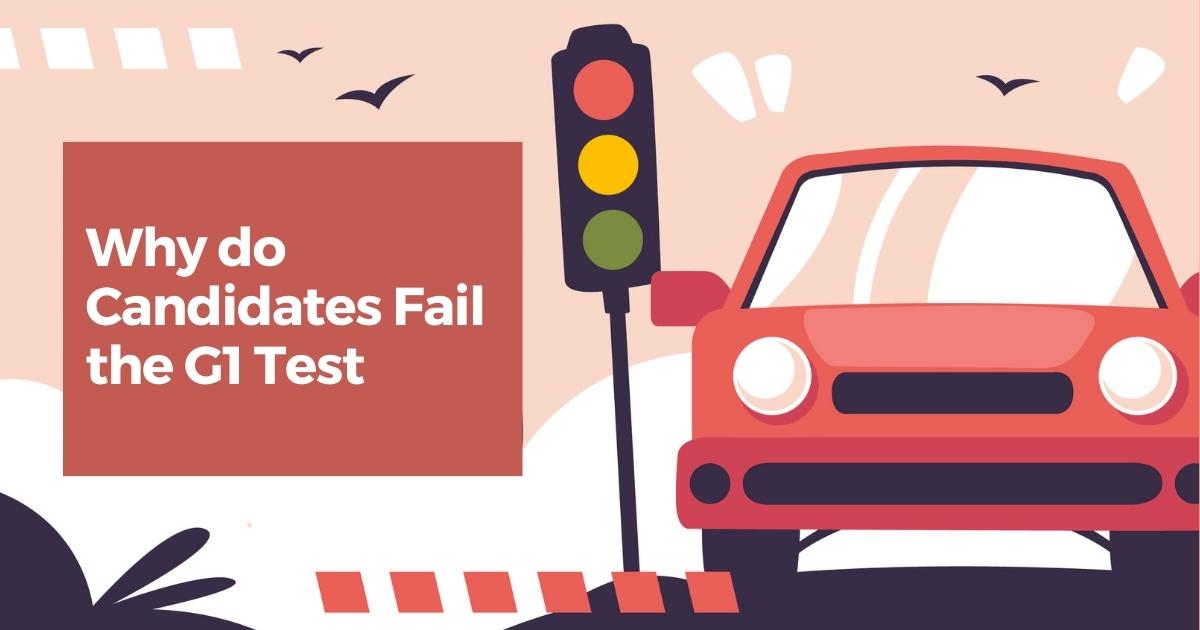Failed Your G1 Test? What's Next
Published on
Failing the Ontario G1 test can feel discouraging, but it’s actually very common. At Rajput Driving School, we remind students that a failed attempt isn’t the end, it’s a chance to identify weak spots and come back stronger the next time. Passing your G1 is the first milestone toward full driving independence, and every driver’s journey looks a little different.

Why People Fail the G1 Test
Before focusing on how the exam works, it helps to know the common reasons new drivers don’t succeed:
- Not reviewing the MTO Driver’s Handbook thoroughly
- Mixing up traffic sign meanings
- Rushing through questions without double-checking
- Getting anxious and losing focus
Restrictions for G1 Drivers (Your Goal After Passing)
Once you pass, your G1 licence comes with strict conditions that every driver must follow:
- You must drive with a fully licensed driver who has 4+ years of experience
- Your supervising driver must have a blood alcohol level below 0.05%
- No driving between midnight and 5 a.m.
- No 400-series highways or high-speed expressways
- Every passenger must wear a seatbelt
What the G1 Test Looks Like
- 40 multiple-choice questions total
- Divided into 2 sections: Traffic Signs & Rules of the Road
- You need at least 16/20 correct in each section (80%)
Advanced Study Strategies for G1 Success
Effective Learning Techniques
Different people learn in different ways. Here are proven study methods that can help you master the G1 test material:
Visual Learning Methods
- Sign Recognition Games: Create games to identify traffic signs quickly
- Color-Coded Study Materials: Use different colors for different types of signs and rules
- Diagram Drawing: Draw intersection layouts and traffic scenarios to understand right-of-way
- Video Learning: Watch educational videos about traffic rules and road safety
Auditory Learning Methods
- Record Yourself: Read important rules aloud and listen to your recordings
- Study Groups: Discuss traffic scenarios with friends or family members
- Audio Books: Listen to the driver's handbook while commuting or exercising
- Mnemonic Devices: Create rhymes or acronyms to remember complex rules
Kinesthetic Learning Methods
- Interactive Practice: Use online interactive tests that provide immediate feedback
- Real-World Application: Practice identifying signs and rules while riding as a passenger
- Physical Flashcards: Create and shuffle physical flashcards for hands-on learning
- Simulation Games: Use driving simulation software to practice decision-making
Comprehensive Test Preparation Plan
Week 1-2: Foundation Building
- Read the Complete Handbook: Go through the MTO Driver's Handbook from cover to cover
- Take Baseline Practice Tests: Identify your current knowledge level and weak areas
- Create Study Schedule: Allocate specific times for studying each day
- Set Up Study Space: Create a distraction-free environment for focused learning
Week 3-4: Skill Development
- Focus on Weak Areas: Spend extra time on topics where you scored poorly
- Practice Test Repetition: Take multiple practice tests to build familiarity
- Flashcard Review: Use flashcards for quick review sessions
- Group Study Sessions: Study with others to reinforce learning
Week 5-6: Mastery and Review
- Timed Practice Tests: Practice completing tests within time limits
- Final Review: Go through all materials one final time
- Mock Test Conditions: Take practice tests under realistic conditions
- Confidence Building: Focus on areas of strength to build confidence
Understanding Test Anxiety and Management
Common Causes of G1 Test Anxiety
Test anxiety can significantly impact performance, even when you know the material well. Understanding the causes can help you manage it effectively:
- Fear of Failure: Worry about not passing and delaying your driving goals
- Unfamiliar Environment: Nervousness about taking the test in an official setting
- Time Pressure: Concern about completing the test within the time limit
- High Stakes: Understanding that this test is required for driving privileges
Anxiety Management Techniques
- Breathing Exercises: Practice deep breathing to calm nerves before and during the test
- Positive Visualization: Imagine yourself successfully completing the test
- Progressive Muscle Relaxation: Learn techniques to release physical tension
- Positive Self-Talk: Replace negative thoughts with encouraging statements
- Proper Preparation: Thorough preparation reduces anxiety by building confidence
Post-Failure Recovery Strategies
Immediate Actions After Failure
If you don't pass the G1 test, it's important to take constructive action immediately:
- Review Your Results: Understand which questions you missed and why
- Identify Patterns: Look for recurring themes in your mistakes
- Set Realistic Timeline: Plan when you'll retake the test based on your improvement needs
- Adjust Study Plan: Modify your study approach based on your performance
Long-term Improvement Strategies
- Seek Additional Resources: Use different study materials if your current ones aren't working
- Consider Professional Help: Look into G1 preparation courses or tutoring
- Practice with Others: Study with friends or family members who can provide different perspectives
- Take Breaks: Don't overstudy - take regular breaks to maintain focus and motivation
Success Stories and Motivation
Learning from Others' Experiences
Many successful drivers faced challenges during their licensing journey. Understanding that failure is part of the learning process can help maintain motivation:
- Common Experience: A significant percentage of drivers don't pass their first attempt
- Learning Opportunity: Each failure provides specific feedback for improvement
- Building Resilience: Overcoming test challenges builds confidence for future driving situations
- Personal Growth: The licensing process teaches persistence and goal-setting skills
Maintaining Motivation
- Remember Your Goals: Keep in mind why you want to drive and the freedom it will provide
- Celebrate Small Wins: Acknowledge improvements in practice test scores
- Visualize Success: Picture yourself with a driver's license and the opportunities it opens
- Stay Positive: Focus on progress rather than setbacks
The Road Ahead
With your G1 in hand, you'll gain the foundation for safe driving experience. After 12 months (or 8 with BDE), you'll attempt the G2 road test to prove your skills in real traffic. Another year later, you'll be eligible for the G test, which includes highway driving, and finally, a full licence.
Rajput Driving School provides step-by-step support for G1, G2, and G road tests. From practice exams to in-car training, our instructors will help you succeed at every stage.
Remember: failing your G1 is just a checkpoint, not the finish line. With the right prep and mindset, you'll pass and move closer to full driving freedom.
Book Your LessonCategories
Recent Posts
- How to Parallel Park in 3 Easy Steps
- Top 5 Tips for Passing Your Driving Test in Windsor
- How to Choose the Right Driving School For You
- Step-by-Step Guide to Getting Your G1, G2, and G Driver's Licence
- The G2 Road Test Examination Sheet Explained
- The G2 Road Test: How to Pass on Your First Try
- 10 Defensive Driving Tips That Can Save Your Life
- What Happens If You Fail Your G Test in Ontario?
- Top 10 Reasons for Failing the G Road Test in Windsor, Ontario
- Winter Driving Safety: 10 Essential Tips
- 10 Reasons Why You Should Take Driver's Ed in Windsor, Ontario
- Common Mistakes People Make on Their G2 Driving Test
